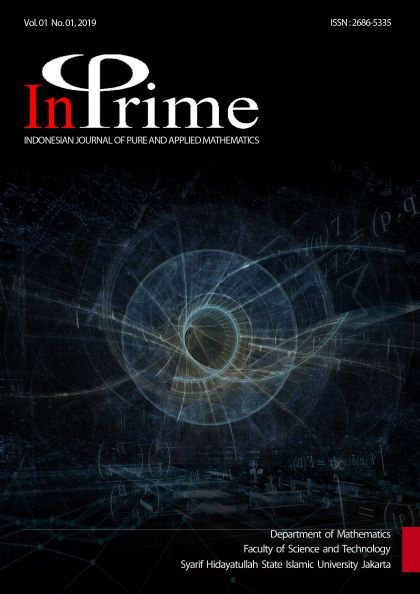Non-linear Mixed Models in a Dose Response Modelling
DOI:
https://doi.org/10.15408/inprime.v1i1.12731Abstract
AbstractStudy designs in which an outcome is measured more than once from time to time result in longitudinal data. Most of the methodological works have been done in the setting of linear and generalized linear models, where some amount of linearity is retained. However, this still be considered a limiting factor and non-linear models is another option offering its flexibility. Non-linear model involves complexity of non-linear dependence on parameters than that in the generalized linear class. It has been utilized in many situations such as modeling of growth curves and dose-response modeling. The latter modeling will be the main interest in this study to construct a dose-response relationship, as a function of time to IBD (inflammatory bowel disease) dataset. The dataset comes from a clinical trial with 291 subjects measured during a 7 week period. Both linear and non-linear models are considered. A dose time response model with generalized diffusion function is utilized for the non-linear models. The fit of non-linear models are found to be more flexible than linear models hence able to capture more variability present in the data.
Keywords: IBD; longitudinal; linear mixed model; non-linear mixed model.
Abstrak
Desain studi dimana hasil diukur berulang kali dari waktu ke waktu menghasilkan data longitudinal. Sebagian besar metodologi yang digunakan untuk menganalisis data longitudinal adalah model linear dan model linear umum (generalized linear model) dimana sejumlah linearitas tertentu dipertahankan. Asumsi linearitas ini masih dipandang memiliki keterbatasan dan model non-linear adalah pilihan metode lainnya yang menawarkan fleksibilitas. Model non-linear telah digunakan di berbagai macam situasi seperti model kurva pertumbuhan , model farmakokinetika, dan farmakodinamika, dan model respon-dosis. Model respon-dosis akan menjadi fokus dalam penelitian ini untuk membangun hubungan dosis-respon sebagai fungsi waktu dari data IBD dengan menggunakan model linear dan non-linear. Hasil penelitian menunjukan bahwa model non-linear lebih fleksibel daripada model linear sehingga mampu menangkap lebih banyak variabilitas yang ada di dalam data.
Keywords: IBD; longitudinal; model linear; model non-linear.
References
J.A. Nelder and R.W.M. Wedderburn, "Generalized linear models.," Journal of the Royal Statistical Society : Series (A) General, vol. 153, no. 3, pp. 370-384, 1972.
G. Molenberghs and G. Verbeke, "Models for Discrete Longintudinal Data," New York: Springer, 2005.
N.J. Talley, M.T. Abreu, J.P. Achkar, C.N. Bernstein, M.C. Dubinsky, S.B. Hanauer, S.V. Kane, W.J. Sandborn, T.A. Ullman, and P. Moayyedis, "An Evidence-Based Systematic Review On Medical Therapies for Inflammatory Bowel Disease," Am J Gastroentrol, vol. 106, pp. S2-S25, April 2011.
C. Abraham and J.H. Cho, "Inflammatory Bowel Disease," The New England Journal of Medicine, vol. 361, no. 21, pp. 2066-2078, November 2009.
R.C. Langan, P.B. Gotsch, M.A. Krafczyk, and D.D. Skillinge, "Ulcerative Colitis: Diagnosis and Treatment.," American Family Physician, vol. 76, no. 9, pp. 1323-1330, November 2007.
G. Verbeke and G. Molenberghs, "Linear Mixed Model for Longintudinal Data.," , New York: Springer, 2000.
J. Serroyen, G. Verbeke, G. Molenberghs, and M. Davidian, "Non-Linear Models for Longintudinal Data," American Statistician, vol. 63, no. 4, pp. 378-388, 2009.
S. Woodruff, "The Use of Mixed-Effects Dose-Response Modeling for Neurotoxicity Risk Assessment," University of South Florida, Master's Thesis, 2001.
Y. Zhu, "Neurobehavioral Toxicity Risk Assessment: Dose-Time-Response Modeling and Bencmark Dose Estimation," National Center for Environmental Assessment, US EPA, 2001.
Y. Zhu, "Technical Guidance Document for Dose-Response Modeling and Benchmark Dose Estimation of Neurobehavioral Toxicity Screening Data," National Center for Environmental Assessment, US EPA, 2003.
Y. Zhu, M.R. Wessel, T. Liu, and V.C. Moser, "Analysis of Neurobehavioral Screening data: Dose-Time-Response Modeling of Continuous Outcome," Regulatory Toxycology Pharmacology, vol. 41, no. 3, pp. 240-255, 2005.

